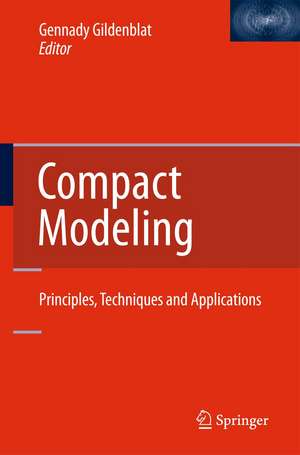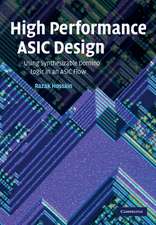Compact Modeling: Principles, Techniques and Applications
Editat de Gennady Gildenblaten Limba Engleză Paperback – 30 sep 2014
| Toate formatele și edițiile | Preț | Express |
|---|---|---|
| Paperback (1) | 901.88 lei 6-8 săpt. | |
| SPRINGER NETHERLANDS – 30 sep 2014 | 901.88 lei 6-8 săpt. | |
| Hardback (1) | 1124.92 lei 6-8 săpt. | |
| SPRINGER NETHERLANDS – 8 sep 2010 | 1124.92 lei 6-8 săpt. |
Preț: 901.88 lei
Preț vechi: 1099.85 lei
-18% Nou
Puncte Express: 1353
Preț estimativ în valută:
172.59€ • 179.17$ • 143.92£
172.59€ • 179.17$ • 143.92£
Carte tipărită la comandă
Livrare economică 22 martie-05 aprilie
Preluare comenzi: 021 569.72.76
Specificații
ISBN-13: 9789400793248
ISBN-10: 9400793243
Pagini: 548
Ilustrații: XVII, 527 p.
Dimensiuni: 155 x 235 x 29 mm
Greutate: 0.76 kg
Ediția:2010
Editura: SPRINGER NETHERLANDS
Colecția Springer
Locul publicării:Dordrecht, Netherlands
ISBN-10: 9400793243
Pagini: 548
Ilustrații: XVII, 527 p.
Dimensiuni: 155 x 235 x 29 mm
Greutate: 0.76 kg
Ediția:2010
Editura: SPRINGER NETHERLANDS
Colecția Springer
Locul publicării:Dordrecht, Netherlands
Public țintă
ResearchCuprins
Compact Models of MOS Transistors.- Surface-Potential-Based Compact Model of Bulk MOSFET.- PSP-SOI: A Surface-Potential-Based Compact Model of SOI MOSFETs.- Benchmark Tests for MOSFET Compact Models.- High-Voltage MOSFET Modeling.- Physics of Noise Performance of Nanoscale Bulk MOS Transistors.- Compact Models of Bipolar Junction Transistors.- to Bipolar Transistor Modeling.- Mextram.- The HiCuM Bipolar Transistor Model.- Compact Models of Passive Devices.- Integrated Resistor Modeling.- The JUNCAP2 Model for Junction Diodes.- Surface-Potential-Based MOS Varactor Model.- Modeling of On-chip RF Passive Components.- Modeling of Multiple Gate MOSFETs.- Multi-Gate MOSFET Compact Model BSIM-MG.- Compact Modeling of Double-Gate and Nanowire MOSFETs.- Statistical Modeling.- Modeling of MOS Matching.- Statistical Modeling Using Backward Propagation of Variance (BPV).
Recenzii
From the reviews:
“This excellent reference covers a niche in the recent development of compact modeling for integrated circuit systems. The book can serve as a guide to current research based on the down-scaling of semiconductor devices, particularly for device physicists, electrical engineers and applied mathematicians. The reader will benefit in particular from the coverage of statistical modeling, which treats stochastic system variability and other random effects … . Each chapter is well documented with references, and the underlying theory for each device class is well demonstrated.” (Axel Mainzer Koenig, Optics & Photonics News, May, 2011)
“This excellent reference covers a niche in the recent development of compact modeling for integrated circuit systems. The book can serve as a guide to current research based on the down-scaling of semiconductor devices, particularly for device physicists, electrical engineers and applied mathematicians. The reader will benefit in particular from the coverage of statistical modeling, which treats stochastic system variability and other random effects … . Each chapter is well documented with references, and the underlying theory for each device class is well demonstrated.” (Axel Mainzer Koenig, Optics & Photonics News, May, 2011)
Textul de pe ultima copertă
Compact Models of circuit elements are models that are sufficiently simple to be incorporated in circuit simulators and are sufficiently accurate to make the outcome of the simulators useful to circuit designers. The conflicting objectives of model simplicity and accuracy make the compact modeling field an exciting and challenging research area for device physicists, modeling engineers and circuit designers.
The models of MOS transistors underwent revolutionary change in the last few years and are now based on new principles. The recent models of diodes, passive elements, noise sources and bipolar transistors were developed along the more traditional lines. Following this evolutionary development they became highly sophisticated and much more capable to reflect the increased demands of the advanced integrated circuit technology. The latter depends on the compact models for the shortening of the design cycle and eliminating the elements of overdesign which is often undesirable in today’s competitive environment. At the same time, statistical modeling of semiconductor devices received new significance following the dramatic reduction of the device dimensions and of the power supply voltage. Finally, despite the complexity of the fabrication process, the multi-gate MOS transistors are now seriously considered for the purpose of controlling the small geometry effects.
Most of the recent texts on compact modeling are limited to a particular class of semiconductor devices and do not provide comprehensive coverage of the field. Having a single comprehensive reference for the compact models of most commonly used semiconductor devices (both active and passive) represents a significant advantage for the reader. Indeed, several kinds of semiconductor devices are routinely encountered in a single IC design or in a single modeling support group. Compact Modeling includes mostly the material that after several years of IC designapplications has been found both theoretically sound and practically significant. Assigning the individual chapters to the groups responsible for the definitive work on the subject assures the highest possible degree of expertise on each of the covered models.
Compact Modeling also includes chapters on the MOSFET noise theory, benchmarking of MOSFET compact models, modeling of the power MOSFET, and an overview of the bipolar modeling field. It concludes with two chapters describing the variability modeling including some recent developments in the field.
The models of MOS transistors underwent revolutionary change in the last few years and are now based on new principles. The recent models of diodes, passive elements, noise sources and bipolar transistors were developed along the more traditional lines. Following this evolutionary development they became highly sophisticated and much more capable to reflect the increased demands of the advanced integrated circuit technology. The latter depends on the compact models for the shortening of the design cycle and eliminating the elements of overdesign which is often undesirable in today’s competitive environment. At the same time, statistical modeling of semiconductor devices received new significance following the dramatic reduction of the device dimensions and of the power supply voltage. Finally, despite the complexity of the fabrication process, the multi-gate MOS transistors are now seriously considered for the purpose of controlling the small geometry effects.
Most of the recent texts on compact modeling are limited to a particular class of semiconductor devices and do not provide comprehensive coverage of the field. Having a single comprehensive reference for the compact models of most commonly used semiconductor devices (both active and passive) represents a significant advantage for the reader. Indeed, several kinds of semiconductor devices are routinely encountered in a single IC design or in a single modeling support group. Compact Modeling includes mostly the material that after several years of IC designapplications has been found both theoretically sound and practically significant. Assigning the individual chapters to the groups responsible for the definitive work on the subject assures the highest possible degree of expertise on each of the covered models.
Compact Modeling also includes chapters on the MOSFET noise theory, benchmarking of MOSFET compact models, modeling of the power MOSFET, and an overview of the bipolar modeling field. It concludes with two chapters describing the variability modeling including some recent developments in the field.
Caracteristici
A comprehensive book on compact models of most commonly used semiconductor devices Each chapter is covered by an expert, often responsible for the widely used model with wide industrial applications Both traditional and experimental devices are covered Critical variability issues are addressed Provides detailed coverage of compact model benchmarking which is critical for model development and applications Includes supplementary material: sn.pub/extras












